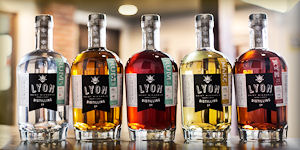American Whiskey
September 3, 2015 |
|
Maryland Rye Whiskey returns to the Free State
![]()
IN 1972 THE LAST DROP of rye whiskey ever made in Maryland came off
the still at the Majestic Distillery in Lansdowne (or Halethorpe, or
Arbutus, depending on who you ask) and no true Maryland Rye has been
distilled since then.
Until now.
Cases of Pikesville Rye continued to be bottled at Majestic for several
years, although the contents were distilled at unnamed facilities in
Pennsylvania, then later at Glenmore in Kentucky. A decade after that the
Heaven Hill company in Bardstown, Kentucky, purchased the brand and it's
been made and bottled by them ever since. Always more popular in Maryland
itself than elsewhere, Heaven Hill has recently revamped the label and
upgraded the quality, as well as expanding its sales base nationwide.
It's still Kentucky rye whiskey, though, and that's not the same thing as
the legendary Maryland Rye. There really are differences between
the three main types of rye whiskey: Monongahela, East
Pennsylvania/Maryland, and what was once known as Maryland Pure Rye.
Monongahela, called that for the geographical area where it originated, is
made mostly from rye grain, with only as much malted barley as necessary
to get it to ferment. East of the Allegheny Mountains, however, rye
whiskey was made from a mash containing a large portion (but less than
half) of corn. This is also the way that Kentucky rye is made, although
that whiskey tends to use more corn in the mix. Maryland rye, as it
existed in its glory days before Prohibition, was usually made from 100%
rye grain, sometimes using malted rye, other times the least amount of
malted barley they could get away with.
Well, that last statement needs to be clarified just a little. The reign
of the Maryland Pure Rye of legend and fable was not really brought to an
end by National Prohibition. In fact, most of those wonderful and
highly-respected old brands never made it as far as the 18th Amendment.
They were done in by the Pure Food and Drug Act of 1906, when it was
determined that they didn't even qualify to label themselves as "whiskey",
let alone "pure rye whiskey". That doesn't mean that they were terrible,
fake, imitation garbage; oh, no, that idea would be spread later by their
competitors who were making "straight whiskey". Certainly some must have
been less than palatable, but others were fine alcohol beverages that
would have continued to be appreciated by discerning customers if they
could have remained in business. Even those examples of Maryland rye that
DID qualify to be labeled "whiskey" were stronger and richer than their East
Pennsylvania counterparts and, despite some current attempts to market
"authentic Maryland-Style" rye whiskies distilled in Kentucky and
Colorado, there really hasn't been a close match for that flavor since the
1940s.
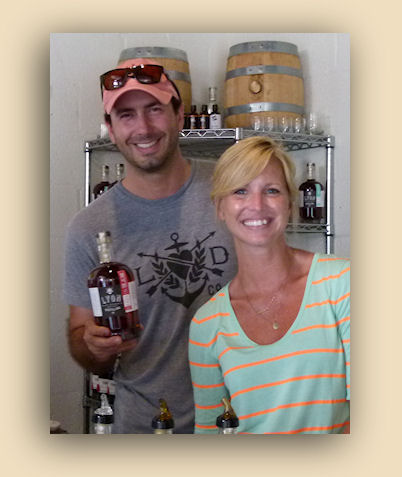
That is, until now...
Early last year, we were contacted by Jaime Windon, a young woman who,
with her partner Ben Lyon, operates the
Lyon distillery in Saint Michaels,
Maryland. Lyon Distilling began making very good rum a few years ago --
three expressions, all of them delicious. Rum has an historic presence in
Maryland. There were five rum distilleries in the state in the 1700s,
and at least one "new age" craft/artisan distillery, Blackwater, has
operated on Kent Island, not far from Saint Michael, since 2008. That
distillery produces mainly artfully-crafted vodka (yes, there is such a
thing; get over it) but early in 2015 released the second
Maryland rum. A couple years earlier than that Jaime and Ben (we prefer to call them that because
somehow "Ben and Jaime" sounds like they should be making ice cream)
started Lyon Distillers and, along with the first new Maryland rum, they decided to distill and age rye whiskey.
Which no one has done since Majestic's still went cold over forty years
ago.
Ben Lyon is the master (and only) distiller here and, while he is
certainly capable of representing the brand, his main concern is with
every single part of the operation of the distillery. Jaime Windon, while
quite expert about the how's and why's of the distilling process (she can
"shop-talk" the ears off most of the bourbon "master distillers" we know),
represents the business and brand development part of the company.
Together they are a force to be reckoned with.
Anyway, back in 2014 they were going to be presenting at a Chicago Spirits
Festival at the end of September and we invited them to take an alternate route back
home to Maryland that passed through Cincinnati and spend an evening
visiting with us. Jaime said they would be happy to come, but
unfortunately that idea had be scrapped when John went into the hospital
just days before their visit. John's fight with cancer ended in complete
victory half a year later, and half a year after that we now find
ourselves in Saint Michaels to complete the visit. We are bringing with us
a few samples of the pre-Prohibition Maryland and Pennsylvania rye they
would have enjoyed last year at our house.
We are not Jaime and Ben's only good source of information about the
history of Maryland Rye. Another, more local and at least as
knowledgeable, person is their friend Teri Perona who holds a deep
fixation on Maryland Rye whiskey history in general and late author Jim Bready in particular. We are fortunate to have Teri join Jaime and Ben at
the distillery the day we visit.
Saint Michaels is a lovely town on what is known as the "East Shore" of
Maryland. To get there from the part of Maryland where Baltimore and
Annapolis and the old Majestic distillery are located, you have to cross Chesapeake Bay over
the Bay Bridge and then drive down the other side of the bay for a bit.
It's an area of little inlets and lots of boats. It smells like crabs. You
want to spend the summer here. And that's just what Jaime and Ben did back when
they were dating. Then they decided not to leave. They opened a
bed-and-breakfast for awhile, but then decided to tap Ben's experience
from his days in
Nantucket, working at the well-known Triple Eight distillery, and start a
distillery of their own, making rum and also Maryland Rye. While the 888
distillery qualifies as a "craft distillery", it's a much larger operation
than Lyon's truly "micro", 100-bottle-a-week capacity.
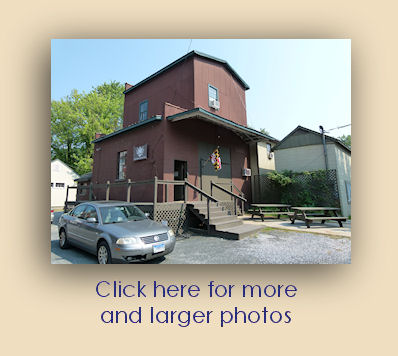 A
block off of Talbot Street (Saint Michaels' main drag) is a barn-red
building, built in the 1890s, that was once the "Just-Right Flour
Company". It's been a long time since flour was being ground there,
and it is now the home of several boutique stores, a wine shop, and a
brewery. And it's a perfect location for a rum-and-whiskey distillery. It
even includes a tall section just the right size to accommodate a modern
column still.
A
block off of Talbot Street (Saint Michaels' main drag) is a barn-red
building, built in the 1890s, that was once the "Just-Right Flour
Company". It's been a long time since flour was being ground there,
and it is now the home of several boutique stores, a wine shop, and a
brewery. And it's a perfect location for a rum-and-whiskey distillery. It
even includes a tall section just the right size to accommodate a modern
column still.
Except there is no column still here. In fact, there isn't even the sort
of pot/column combination still that has become a common feature of
today's craft distilleries. In its place is a battery of five tiny stills,
each only 26 gallons in capacity. These are true pot stills, made of
gleaming stainless steel with shiny copper gooseneck heads, and were built
by the HillBilly Still Company in Barlow, Kentucky.
We've seen many stills in our our travels, but these are the first ones
that Linda has ever described as "adorable".
The first spirit produced here was rum, which remains Lyon's chief
product. Rum is a liquor characterized by dramatically varying styles,
such that each Caribbean island seems to have its own distinct flavor,
even when produced at different distilleries on that island. Rums fall
broadly into two categories, those that are made from molasses (a
by-product of cane sugar production) and those made directly from
fermented sugar cane juice itself. In the United States there are only a
few small distilleries that actually produce rum, and even in areas like
New Orleans where sugar cane is grown, almost all of those distill only
from molasses. Ben ferments a hybrid wash of both molasses and raw
sugarcane juice and carefully distills it to produce a rum with
characteristics unlike any other he's tasted.
And Ben has tasted a lot of characteristics. So has Jaime. One thing (of
many) that sets them apart from other distillers we've had the pleasure to
visit is the knowledge they have of what other distillers are doing, and
have done in the past. Both were spirits enthusiasts before they began
this venture and both had ideas of what they wanted their finished product
to be. How to go about achieving that is Ben Lyon's talent. That's why he
chose to install a battery of tiny -- but infinitely controllable --
stills instead of a single large one. That's why he chooses to age his
spirit in very small barrels, checking for maturity by the week or month
instead of annually.
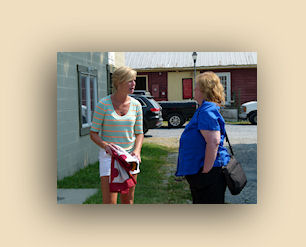 Distribution
of Lyon's spirits is limited to on-site plus a few local restaurants and
taverns; they simply don't produce enough to attract a distributor, and
they aren't planning to expand greatly anytime soon.
Distribution
of Lyon's spirits is limited to on-site plus a few local restaurants and
taverns; they simply don't produce enough to attract a distributor, and
they aren't planning to expand greatly anytime soon.
We arrive in the morning and are greeted in the parking lot (well, such as
it is; "over there under that tree looks like a good place") by
Jaime Windon, as vivacious a brand ambassador as you'll ever meet. She
welcomes us into the distillery where we meet Ben and their friend Teri.
Ben Lyon shares with other true "craft/artisan" distillers we've met a
love of the craft. His selection of what grains or sugars to ferment,
which yeasts, what temperatures, and so forth is carefully considered. His
use of the five tiny stills allows him the opportunity to fine-tune the
distilling process in ways not available with larger equipment. He uses
all five for the stripping run and three for the spirit run. Four of the
stills have short goosenecks, rather than plated columns, and the fifth
has an even shorter (eight-inch) neck to fine-tune the reflux just that
much more closely. His barreling methods are equally unique and carefully
thought out. Ben uses
very small barrels: 3-gallon used bourbon barrels for rum; only one
gallon, new charred oak, for whiskey.
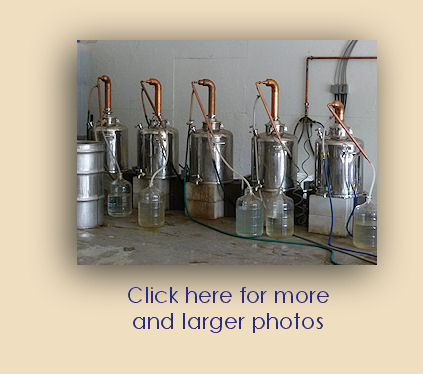 "What?,"
you say, "That's heresy! You can't age whiskey OR rum in such tiny
barrels! It will taste awful!". But wait; there's more. Ben ages his
Maryland rye whiskey only nine months... more or less. "You see," he says,
"in such small cooperage as this, the changes come very rapidly. We check
the spirit often and bottle it when it's just right. If we left it in
there for a year it would taste..." well, like other distillers'
small-barrel offerings. Lyon Maryland Free State Rye doesn't.
"What?,"
you say, "That's heresy! You can't age whiskey OR rum in such tiny
barrels! It will taste awful!". But wait; there's more. Ben ages his
Maryland rye whiskey only nine months... more or less. "You see," he says,
"in such small cooperage as this, the changes come very rapidly. We check
the spirit often and bottle it when it's just right. If we left it in
there for a year it would taste..." well, like other distillers'
small-barrel offerings. Lyon Maryland Free State Rye doesn't.
By the way, there is a reason they call it that. When National Prohibition
was enacted in 1920 the state of Maryland made it clear that it would not
fund any enforcement of the federal Amendment. Thus, the term "Maryland
Free State". There will probably never be a "Lyon Straight Maryland Rye",
because two years would be far too long for Ben's whiskey to age in those
small barrels, and Lyon Distillers are quite content to produce a rare and
hard-to-get product whose success may well be the result of their small
scale. In doing so they join a small handful of American distillers whose
excellence can only be sampled by those lucky enough to find themselves in
their makers' immediate vicinity.
Oh, and they also produce and distill "new-make" corn whiskey which is
90% corn, 8% malted barley and just 2% rye for a little extra flavor.
Although they call it "new-make", it is technically aged corn whiskey...
aged all of 18 hours in one of Ben's tiny wooden barrels!
 |
|
|
Story and original photography copyright © 2015 by John F. Lipman. All rights reserved. |
|
